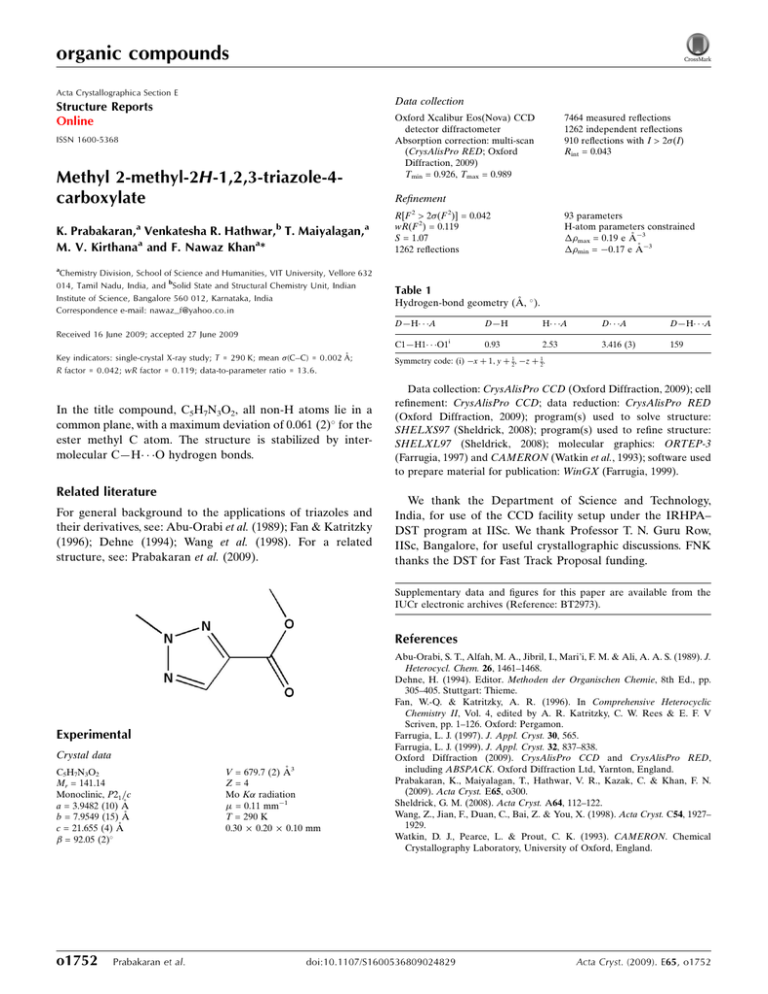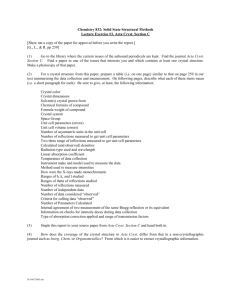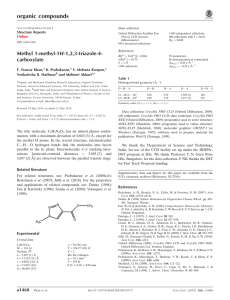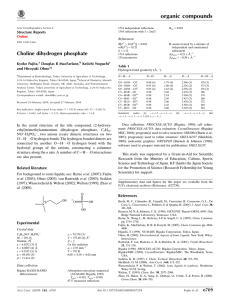Document 13576121
advertisement

organic compounds Acta Crystallographica Section E Data collection Structure Reports Online ISSN 1600-5368 Methyl 2-methyl-2H-1,2,3-triazole-4carboxylate a b K. Prabakaran, Venkatesha R. Hathwar, T. Maiyalagan, M. V. Kirthanaa and F. Nawaz Khana* 7464 measured reflections 1262 independent reflections 910 reflections with I > 2(I) Rint = 0.043 Oxford Xcalibur Eos(Nova) CCD detector diffractometer Absorption correction: multi-scan (CrysAlisPro RED; Oxford Diffraction, 2009) Tmin = 0.926, Tmax = 0.989 Refinement a R[F 2 > 2(F 2)] = 0.042 wR(F 2) = 0.119 S = 1.07 1262 reflections 93 parameters H-atom parameters constrained max = 0.19 e Å3 min = 0.17 e Å3 a Chemistry Division, School of Science and Humanities, VIT University, Vellore 632 014, Tamil Nadu, India, and bSolid State and Structural Chemistry Unit, Indian Institute of Science, Bangalore 560 012, Karnataka, India Correspondence e-mail: nawaz_f@yahoo.co.in Table 1 Hydrogen-bond geometry (Å, ). D—H A D—H H A D A D—H A 0.93 2.53 3.416 (3) 159 Received 16 June 2009; accepted 27 June 2009 C1—H1 O1 i Key indicators: single-crystal X-ray study; T = 290 K; mean (C–C) = 0.002 Å; R factor = 0.042; wR factor = 0.119; data-to-parameter ratio = 13.6. Symmetry code: (i) x þ 1; y þ 12; z þ 12. In the title compound, C5H7N3O2, all non-H atoms lie in a common plane, with a maximum deviation of 0.061 (2) for the ester methyl C atom. The structure is stabilized by intermolecular C—H O hydrogen bonds. Data collection: CrysAlisPro CCD (Oxford Diffraction, 2009); cell refinement: CrysAlisPro CCD; data reduction: CrysAlisPro RED (Oxford Diffraction, 2009); program(s) used to solve structure: SHELXS97 (Sheldrick, 2008); program(s) used to refine structure: SHELXL97 (Sheldrick, 2008); molecular graphics: ORTEP-3 (Farrugia, 1997) and CAMERON (Watkin et al., 1993); software used to prepare material for publication: WinGX (Farrugia, 1999). Related literature For general background to the applications of triazoles and their derivatives, see: Abu-Orabi et al. (1989); Fan & Katritzky (1996); Dehne (1994); Wang et al. (1998). For a related structure, see: Prabakaran et al. (2009). We thank the Department of Science and Technology, India, for use of the CCD facility setup under the IRHPA– DST program at IISc. We thank Professor T. N. Guru Row, IISc, Bangalore, for useful crystallographic discussions. FNK thanks the DST for Fast Track Proposal funding. Supplementary data and figures for this paper are available from the IUCr electronic archives (Reference: BT2973). References Experimental Crystal data C5H7N3O2 Mr = 141.14 Monoclinic, P21 =c a = 3.9482 (10) Å b = 7.9549 (15) Å c = 21.655 (4) Å = 92.05 (2) o1752 Prabakaran et al. V = 679.7 (2) Å3 Z=4 Mo K radiation = 0.11 mm1 T = 290 K 0.30 0.20 0.10 mm Abu-Orabi, S. T., Alfah, M. A., Jibril, I., Mari’i, F. M. & Ali, A. A. S. (1989). J. Heterocycl. Chem. 26, 1461–1468. Dehne, H. (1994). Editor. Methoden der Organischen Chemie, 8th Ed., pp. 305–405. Stuttgart: Thieme. Fan, W.-Q. & Katritzky, A. R. (1996). In Comprehensive Heterocyclic Chemistry II, Vol. 4, edited by A. R. Katritzky, C. W. Rees & E. F. V Scriven, pp. 1–126. Oxford: Pergamon. Farrugia, L. J. (1997). J. Appl. Cryst. 30, 565. Farrugia, L. J. (1999). J. Appl. Cryst. 32, 837–838. Oxford Diffraction (2009). CrysAlisPro CCD and CrysAlisPro RED, including ABSPACK. Oxford Diffraction Ltd, Yarnton, England. Prabakaran, K., Maiyalagan, T., Hathwar, V. R., Kazak, C. & Khan, F. N. (2009). Acta Cryst. E65, o300. Sheldrick, G. M. (2008). Acta Cryst. A64, 112–122. Wang, Z., Jian, F., Duan, C., Bai, Z. & You, X. (1998). Acta Cryst. C54, 1927– 1929. Watkin, D. J., Pearce, L. & Prout, C. K. (1993). CAMERON. Chemical Crystallography Laboratory, University of Oxford, England. doi:10.1107/S1600536809024829 Acta Cryst. (2009). E65, o1752 supporting information supporting information Acta Cryst. (2009). E65, o1752 [doi:10.1107/S1600536809024829] Methyl 2-methyl-2H-1,2,3-triazole-4-carboxylate K. Prabakaran, Venkatesha R. Hathwar, T. Maiyalagan, M. V. Kirthana and F. Nawaz Khan S1. Comment Triazoles and their derivatives find their application in pharmaceuticals, agrochemicals, dyes, photographic materials, and in corrosion inhibition (Fan & Katritzky, 1996; Dehne,1994; Abu-Orabi et al., 1989). In continuous of our earlier report (Prabakaran et al., 2009), here the crystal structure of the title compound is presented. All non-H atoms lie in a common plane with maximum deviation of 0.061 (2)° for atom C4. The packing is stabilized by C—H···O hydrogen bonds. S2. Experimental To Methyl 1H-1,2,3-triazole-4-carboxylate (2 g) in dry DMF (15 ml) maintained at 273 K in nitrogen atmosphere, was added K2CO3 (1.3 g), metyliodide (ml), the mixture was then stirred at 273 K for 1hr, allowed to warm to room temperature and stirred till completion of reaction, monitored by TLC. The reaction mixture on LCMS analysis showed three isomers well separated with their significant retention time and high purity. Three fractions were identified by mass spectroscopy. The solvent was evaporated under vacuo and the residue was isolated into individual isomers by column chromatography. A portion of the mixture was also analysed by HPLC analysis and also isolated by preparative HPLC techniques. The single crystal of the title compound for X-ray structure anlaysis was obtained from ether solution by slow evaporation. S3. Refinement All the H atoms in were positioned geometrically and refined using a riding model with C—H bond lenghts of 0.93 Å and 0.96 Å for aromatic and for methyl H atoms respectively and Uiso(H) = 1.2Ueq(C) and Uiso(H) = 1.5Ueq(Cmethyl). The methyl groups were allowed to rotate but not to tip. Acta Cryst. (2009). E65, o1752 sup-1 supporting information Figure 1 ORTEP diagram of the asymmetric unit of (I) with 50% probability displacement ellipsoids. Methyl 2-methyl-2H-1,2,3-triazole-4-carboxylate Crystal data C5H7N3O2 Mr = 141.14 Monoclinic, P21/c Hall symbol: -P 2ybc a = 3.9482 (10) Å b = 7.9549 (15) Å c = 21.655 (4) Å β = 92.05 (2)° V = 679.7 (2) Å3 Z=4 F(000) = 296 Dx = 1.379 Mg m−3 Mo Kα radiation, λ = 0.71073 Å Cell parameters from 783 reflections θ = 2.0–21.4° µ = 0.11 mm−1 T = 290 K Plate, colorless 0.30 × 0.20 × 0.10 mm Data collection Oxford Xcalibur Eos(Nova) CCD detector diffractometer Radiation source: Enhance (Mo) X-ray Source Graphite monochromator ω scans Absorption correction: multi-scan (CrysAlis PRO RED; Oxford Diffraction, 2009) Tmin = 0.926, Tmax = 0.989 7464 measured reflections 1262 independent reflections 910 reflections with I > 2σ(I) Rint = 0.043 θmax = 25.5°, θmin = 3.2° h = −4→4 k = −9→9 l = −26→26 Refinement Refinement on F2 Least-squares matrix: full R[F2 > 2σ(F2)] = 0.042 wR(F2) = 0.119 S = 1.07 1262 reflections 93 parameters 0 restraints Acta Cryst. (2009). E65, o1752 Primary atom site location: structure-invariant direct methods Secondary atom site location: difference Fourier map Hydrogen site location: inferred from neighbouring sites H-atom parameters constrained sup-2 supporting information w = 1/[σ2(Fo2) + (0.0589P)2 + 0.0659P] where P = (Fo2 + 2Fc2)/3 (Δ/σ)max < 0.001 Δρmax = 0.19 e Å−3 Δρmin = −0.17 e Å−3 Special details Geometry. All e.s.d.'s (except the e.s.d. in the dihedral angle between two l.s. planes) are estimated using the full covariance matrix. The cell e.s.d.'s are taken into account individually in the estimation of e.s.d.'s in distances, angles and torsion angles; correlations between e.s.d.'s in cell parameters are only used when they are defined by crystal symmetry. An approximate (isotropic) treatment of cell e.s.d.'s is used for estimating e.s.d.'s involving l.s. planes. Fractional atomic coordinates and isotropic or equivalent isotropic displacement parameters (Å2) N1 N2 N3 O1 O2 C1 H1 C2 C3 C4 H4A H4B H4C C5 H5A H5B H5C x y z Uiso*/Ueq 0.2453 (4) 0.3338 (4) 0.4803 (5) 0.3755 (4) 0.1319 (4) 0.4849 (6) 0.5707 0.3408 (5) 0.2884 (5) 0.0524 (6) −0.0937 −0.0597 0.2579 0.2690 (6) 0.1463 0.1374 0.4805 0.56849 (18) 0.71794 (19) 0.8185 (2) 0.42664 (18) 0.29948 (17) 0.7258 (2) 0.7596 0.5700 (2) 0.4274 (2) 0.1556 (3) 0.1895 0.0720 0.1095 0.7700 (3) 0.6831 0.8715 0.7896 0.43005 (7) 0.45090 (7) 0.41047 (7) 0.27655 (6) 0.35597 (6) 0.35967 (9) 0.3222 0.37131 (8) 0.32930 (8) 0.31750 (10) 0.2834 0.3414 0.3022 0.51385 (9) 0.5342 0.5130 0.5359 0.0442 (4) 0.0449 (4) 0.0562 (5) 0.0620 (5) 0.0539 (4) 0.0547 (6) 0.066* 0.0407 (5) 0.0435 (5) 0.0634 (6) 0.095* 0.095* 0.095* 0.0567 (6) 0.085* 0.085* 0.085* Atomic displacement parameters (Å2) N1 N2 N3 O1 O2 C1 C2 C3 C4 C5 U11 U22 U33 U12 U13 U23 0.0534 (11) 0.0581 (11) 0.0755 (13) 0.0904 (12) 0.0715 (10) 0.0740 (15) 0.0454 (11) 0.0502 (12) 0.0752 (16) 0.0770 (16) 0.0371 (9) 0.0348 (9) 0.0424 (10) 0.0553 (9) 0.0457 (8) 0.0480 (12) 0.0381 (10) 0.0422 (11) 0.0449 (12) 0.0479 (13) 0.0423 (9) 0.0419 (9) 0.0511 (10) 0.0413 (8) 0.0450 (8) 0.0427 (11) 0.0388 (10) 0.0382 (10) 0.0699 (15) 0.0455 (11) −0.0034 (7) −0.0033 (7) −0.0100 (9) 0.0058 (8) −0.0120 (7) −0.0060 (10) 0.0017 (8) 0.0072 (9) −0.0064 (11) −0.0022 (10) 0.0041 (7) 0.0029 (7) 0.0069 (9) 0.0164 (7) 0.0066 (6) 0.0109 (10) 0.0034 (8) 0.0018 (8) 0.0016 (12) 0.0067 (10) 0.0000 (7) −0.0004 (7) 0.0050 (8) 0.0007 (6) −0.0058 (6) 0.0065 (9) 0.0050 (8) 0.0038 (8) −0.0155 (10) −0.0084 (9) Geometric parameters (Å, º) N1—N2 N1—C2 Acta Cryst. (2009). E65, o1752 1.315 (2) 1.340 (2) C1—H1 C2—C3 0.9300 1.464 (3) sup-3 supporting information N2—N3 N2—C5 N3—C1 O1—C3 O2—C3 O2—C4 C1—C2 1.333 (2) 1.456 (2) 1.325 (2) 1.205 (2) 1.333 (2) 1.444 (2) 1.391 (3) C4—H4A C4—H4B C4—H4C C5—H5A C5—H5B C5—H5C 0.9600 0.9600 0.9600 0.9600 0.9600 0.9600 N2—N1—C2 N1—N2—N3 N1—N2—C5 N3—N2—C5 C1—N3—N2 C3—O2—C4 N3—C1—C2 N3—C1—H1 C2—C1—H1 N1—C2—C1 N1—C2—C3 C1—C2—C3 O1—C3—O2 O1—C3—C2 103.75 (15) 115.69 (15) 121.67 (15) 122.63 (16) 103.33 (16) 116.74 (16) 109.13 (17) 125.4 125.4 108.10 (16) 123.02 (17) 128.88 (17) 124.03 (17) 123.65 (18) O2—C3—C2 O2—C4—H4A O2—C4—H4B H4A—C4—H4B O2—C4—H4C H4A—C4—H4C H4B—C4—H4C N2—C5—H5A N2—C5—H5B H5A—C5—H5B N2—C5—H5C H5A—C5—H5C H5B—C5—H5C 112.31 (16) 109.5 109.5 109.5 109.5 109.5 109.5 109.5 109.5 109.5 109.5 109.5 109.5 C2—N1—N2—N3 C2—N1—N2—C5 N1—N2—N3—C1 C5—N2—N3—C1 N2—N3—C1—C2 N2—N1—C2—C1 N2—N1—C2—C3 N3—C1—C2—N1 0.1 (2) 179.01 (17) 0.2 (2) −178.75 (18) −0.3 (2) −0.3 (2) −179.42 (17) 0.4 (2) N3—C1—C2—C3 C4—O2—C3—O1 C4—O2—C3—C2 N1—C2—C3—O1 C1—C2—C3—O1 N1—C2—C3—O2 C1—C2—C3—O2 179.47 (18) −2.7 (3) 176.96 (16) −179.38 (18) 1.7 (3) 1.0 (3) −177.96 (19) Hydrogen-bond geometry (Å, º) D—H···A i C1—H1···O1 D—H H···A D···A D—H···A 0.93 2.53 3.416 (3) 159 Symmetry code: (i) −x+1, y+1/2, −z+1/2. Acta Cryst. (2009). E65, o1752 sup-4




